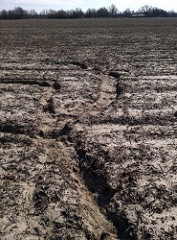Released: Dec. 19, 2016
K-State researcher develops soil health research program in SE Kansas
Work is designed to keep more sediment, nutrients in farmers’ fields and less in water supply.

PARSONS, Kan. – A Kansas State University researcher is looking for ways to keep soil and nutrients on farm fields and reduce the amount washing into the water supply through erosion. That helps farmers and improves water quality for everyone in southeast Kansas where the work is under way.
Gretchen Sassenrath, K-State associate professor of agronomy, is developing a soil health research program to better understand the mechanisms contributing to soil erosion and the extent of that erosion in crop production fields. She and a team of researchers are trying to determine if underlying soil characteristics, such as the claypan layer prevalent in southeast Kansas soils, exacerbate soil loss.
“We are studying crop production and the mechanisms of soil erosion to develop ways of managing the crops (reduced or no-tillage; cover crops; crop rotations) that improves the soil health, increases crop productivity, and also benefits the waterways,” said Sassenrath, who is based in Parsons, Kansas. “The decline in water quality is an obvious off-farm impact of poor soil health. Cleaning up the water starts with healthy soils.”
The researcher’s current work centers on the Middle Neosho Watershed which encompasses portions of five predominantly agricultural counties in southeast Kansas. The watershed ends where the Neosho River crosses the state line into Oklahoma. Agricultural activities together with high rainfall rates in that part of Kansas contribute to a loss of sediments and nutrients from erosion-prone silt loam soils in the area.
That erosion has impaired the water quality of streams and rivers in the area as well as downstream water in neighboring states. Such negative environmental impacts are similar to problems occurring in other locations in the United States and the world.
A University Small Research Grant from the K-State Office of Research and Sponsored Programs in fall 2015 helped Sassenrath analyze terrain, take soil samples, and test and map soil electrical conductivity. Relating soil electrical conductivity to physical properties of soils shows the extent of soil variability within a field, changes in soil textural characteristics with depth in the soil (such as clay content), and the depth of the productive silt-loam topsoil layer.
“To date, we have found the depth to claypan varies greatly across a field. Moreover, the extent of topsoil loss is not consistent with topographic position, so other factors appear to play a greater role in sediment and nutrient loss,” Sassenrath said.
“Understanding the fundamental processes of erosion in these claypan soils allows us to develop better management practices to reduce sediment and nutrient loading to streams and waterways,” she said.
Sassenrath presented her research results at recent conferences including the Governor’s Conference on the Future of Water in Kansas in November. She also regularly communicates with southeast Kansas producers through K-State Research and Extension.
She has submitted a proposal to the National Science Foundation for continued funding of the work.
Sassenrath’s project was also supported by the K-State Southeast Research and Extension Center in Parsons.
-30-
K‑State Research and Extension is a short name for the Kansas State University Agricultural Experiment Station and Cooperative Extension Service, a program designed to generate and distribute useful knowledge for the well‑being of Kansans. Supported by county, state, federal and private funds, the program has county Extension offices, experiment fields, area Extension offices and regional research centers statewide. Its headquarters is on the K‑State campus in Manhattan.
K-State Research and Extension
http://www.ksre.ksu.edu
Story by:
Sarah Hancock - 785-532-5045 or sarhan@ksu.edu
For more information:
Gretchen Sassenrath - 620-820-6131 or gsassenrath@ksu.edu
